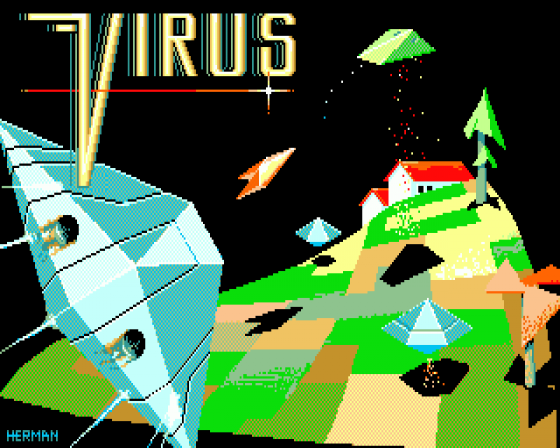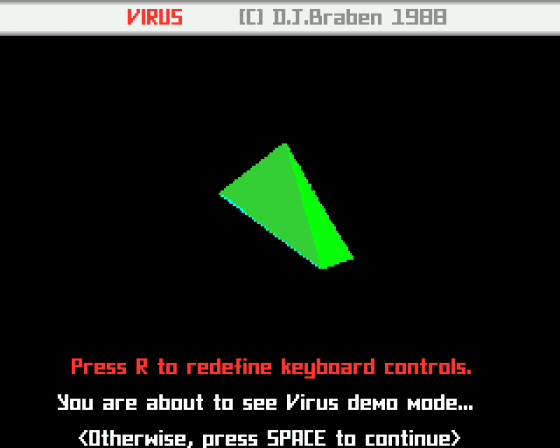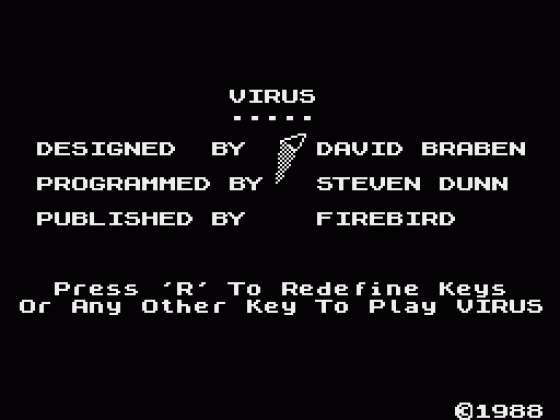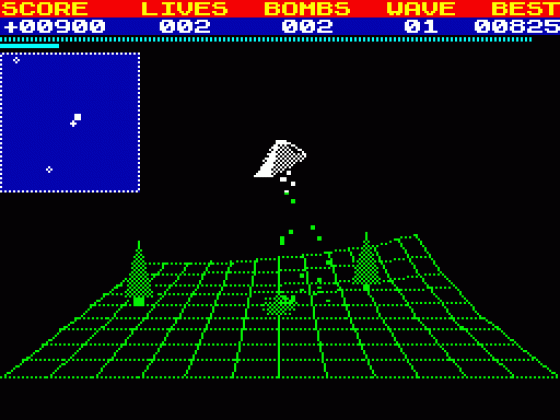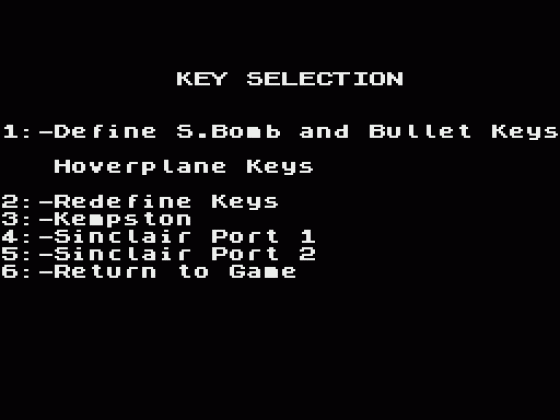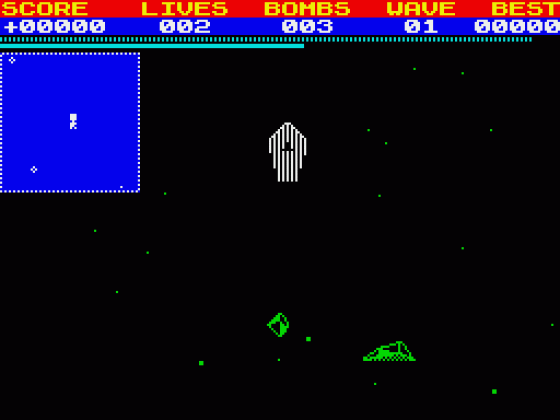
C&VG
 1st August 1988
1st August 1988
Author: Julian Rignall
Publisher: Firebird
Machine: Spectrum 48K
Published in Computer & Video Games #82
Virus
Virus was first exposed to the public at the last PCW show; then it was called Zarch and was only available for the mighty Acorn Archimedes. Since then, author David Braben has been busy converting it to the Atari ST and Amiga - and the end result is nothing short of spectacular.
It's a unique game, and is as much an innovation as Ultimate's 3D forced perspective filmation format was four years ago. The plot doesn't break any new grounds - the player takes command of a hoverplane and patrols a map of islands, mountains and sea, defending it from invading alien spaceships who are trying to infect the land with a deadly red virus - it's the approach and presentation that makes Virus very special indeed.
The action is played over a solid, true 3D perspective world, with the player having a remote view of the hoverplane. The visual effect is incredible; the landscape is made up of an undulating subtly-coloured checkerboard of greens and browns and scrolls smoothly as the overplane flies around. Dotted across the land are different types of trees, bushes, radar towers and houses, all of which move in smooth 3D.
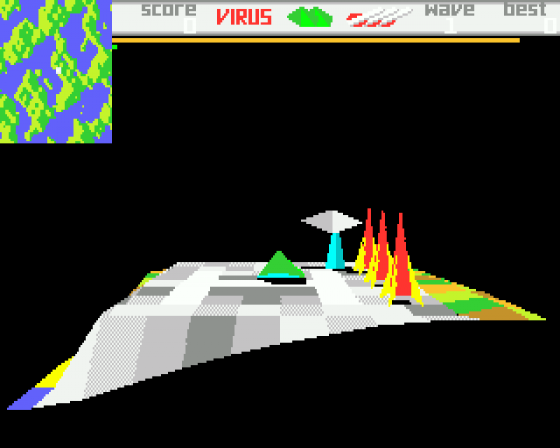
Fly upwards and the ground scrolls off the bottom of the screen; fly fighter and the craft runs into glowing 'space debris', a sort of high altitude snowstorm which moves in a highly convincing parallax fashion. Giving the game an even more solid look is the ultra-realistic shadow cast by the hoverplane, which changes as the craft zooms over the gently rolling landscape. A really nice touch is seen when flying low over the sea; water drops - complete with shadows - spray everywhere as the plane's jet blasts the surface.
The hoverplane is mouse or keyboard controlled and tilts and thrusts in any direction. It must be said that the control method is very tricky indeed - the hoverplane responds to the slightest twitch of the mouse - but perseverence pays off, and once you're used to the way the craft pitches and yaws, flying becomes second nature. The hoverplane is also equipped with a laser cannon and three homing missiles for use against the marauding enemy.
A game begins with the hoverplane parked on the landing platform. Within a few seconds the invasion starts; the location of all enemy activity is displayed as coloured dots on a miniature scanner/map at the top left of the screen.

There are eight types of alien craft. Seeders roam around polluting the landscape with virus spray while Bombers fly at high speed dropping parachute bombs that contain cannisters of concentrated virus. Neither are aggressive. Attractors, on the other hand, fire lightning bolts at the landscape and use their tractor beam to drain the hoverplane of its energy, shown as a diminishing bar at the top of the screen. When energy is low the plane can return to the landing platform to refuel.
The other five craft are entirely aggressive. Drones trail the hoverplane and attempt to destroy it. If one shoots a tree, or bush infected by the virus, it becomes a Mutant, a similar, but bigger and more powerful craft. Pests home in kamikaze-style, and deadly Fighters boasting similar armament and manoeuvrability to the hoverplane engage in dogfights whenever they can. Finally, there's a mystery spacecraft which appears later in the game and 'may have' a lethal weapons system filled.
Whenever a craft is destroyed, bits fly everywhere, and larger chunks of debris float slowly earthwards, smoking as they fall. Indeed, destroying anything results in a plume of snoke, and trees and the like continue to burn for long periods of time, adding to the game's realism.
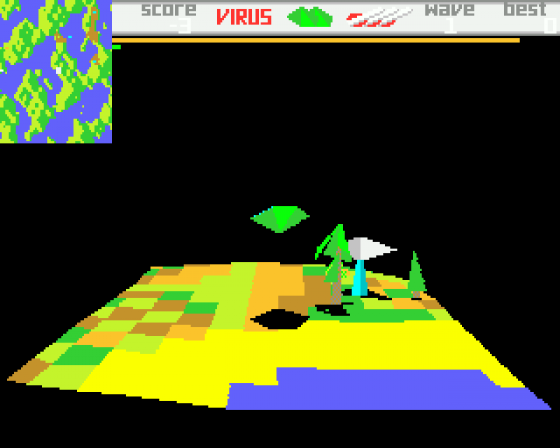
The sound effects are a little harsh and tinny, but they have been intelligently used. Each craft makes its own distinctive noise, which increases and decreases in volume as it approaches and retreats - yet another clever ploy to enhance the feeling of 'being there'.
When an entire attack fleet is destroyed a bonus is awarded for the amount of uninfected landscape remaining, and the player goes on to tackle the next, more aggressive invasion force. Every fifth wave the landscape is disinfected, and the gravity is increased on waves three, five and seven. An extra life is awarded every 5,000 points.
Virus is simply incredible. I've never played a game that has felt so real; the hoverplane's inertia, the gravity, the way the sound works and the amazing 3D effect generated by the graphics all conspire together to make a game of classic dimensions; a landmark in 16-bit entertainment. Time and patience are required before enjoyment is gleaned, but to be honest I can't think of a game more deserving of such perseverence.
Other Spectrum 48K Game Reviews By Julian Rignall
Scores
Atari ST Version| Graphics | 90% |
| Sound | 50% |
| Playability | 90% |
| Value For Money | 80% |
| Overall | 90% |
Scores
Spectrum 48K Version| Graphics | 90% |
| Sound | 50% |
| Playability | 90% |
| Value For Money | 80% |
| Overall | 90% |
Scores
Amiga 500 Version| Graphics | 90% |
| Sound | 50% |
| Playability | 90% |
| Value For Money | 80% |
| Overall | 90% |


